INTRODUCTION
Diarrhoea is one of the most common side effects of antibiotic therapy. The disruption of the normal enteric flora caused by antibiotics may lead to overgrowth of pathogens and functional disturbances of the intestinal carbohydrate and bile acid metabolism, resulting in osmotic diarrhoea [1].
There is a growing concern about the nosocomial colonisation and infection with Clostridium difficile in patients receiving broad spectrum antibiotics. Clostridium difficile is a gram positive, spore forming anaerobic bacillus. Use of any antibiotic in general and broad spectrum antibiotic in particular causes disruption of the microflora of the intestine. After disruption of the colonic microflora, colonisation of Clostridium difficile generally occurs through the ingestion of heat resistant spores, which convert to vegetative forms in the colon [2]. Depending on the host factors, an asymptomatic carrier state or clinical manifestations of Clostridium difficile colitis develop [2].
Risk factors of Clostridium difficile include prolonged hospital stay, course of antibiotics and elderly and frail population. Increased risk is partly to the debilitated patient’s inability to mount an IgG antibody response against Clostridium difficile toxin A [3]. The ability to mount an immune response is not protective against Clostridium difficile colonisation, but it is associated with decreased morbidity, mortality, and recurrence of Clostridium difficile- associated diarrhoea [4-5].
METHODOLOGY
The study was conducted in Wansbeck General Hospital which is about 300 bedded District General Hospital in Northumberland, North East of England. The hospital deals with about 24,000 inpatients, 21,000 outpatients, 14,000 day cases and 36,000 emergency attendees each year. In the Hospital, there were 82 Clostridium difficile positive cases in 2004. We audited the management of patients with Clostridium difficile positive diarrhoea over a period of 3 months from October 2004 to December 2004. This constituted 24 cases. We studied the demographic features of the infection, including the age, sex, and residential status of the patients. We used the Trust guidelines as the standard for management.
RESULTS
All the patients in our survey were elderly. Incidence of infection rising with the advanced age showed more than 70% being over 80 years old (Figure 1).
 |
There was no sex difference in the infection rates. Two third of the patients were admitted from home (Table 1). At the time of admission there were asymptomatic and had no diarrhoea. This reinforces the fact that the Clostridium difficile infection is a nosocomial infection.
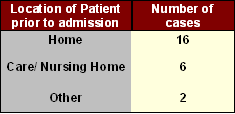 |
Forty one percent (10 cases) of cases were treated with a Cephalosporin and Thirty seven percent (9 cases) were treated with a Penicillin, making these antibiotics most commonly associated with the Clostridium diarrhoea (Table 2). But we should bear in mind these are perhaps most commonly prescribed antibiotics as well.
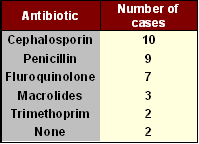 |
Table 3 shows reasons for starting antibiotic in these 24 cases. The chest infection was the most common reason to give antibiotic.
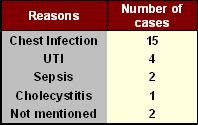 |
In one third of the cases the diarrhoea started over a fortnight after the admission in the hospital. But in about 40 percent (10 cases) of patients the diarrhoea started within first ten days in hospital (Table 4). Longer stay in hospital was associated with increased incidence of the diarrhoea, which in turn delays their discharges.
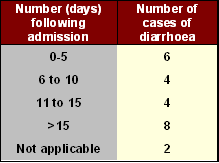 |
In fifteen cases the diarrhoea started within ten days of stopping the antibiotic or completing the course of the antibiotic (Table 5).
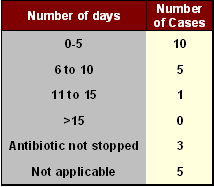 |
In our audit the Metronidazole was started in twenty one cases but only in three cases full ten day course of Metronidazole was given. In fourteen cases the diarrhoea settled and four cases had recurrence which was treated successfully by repeat course of Metronidazole. There were six deaths which is quarter of the cases studied (Table 6).
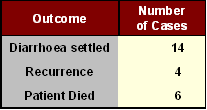 |
DISCUSSION
The Clostridium difficile infection is associated with frail and elderly population which are on antibiotic for infection. The infection can be a contributory factor for the death of the patients if not the primary cause for it. In our series one of the patients was treated with second line treatment of Vancomycin and none of them received any anti-diarrhoeal agents.
Diagnosis can be made by careful history and history of use of antibiotics. A combination immunoassay that is currently in development tests for C. difficile toxin A and B (specificity 97 to99 %) [6].
Treatment is dependent on the severity of the diarrhoea and concurrent use of antibiotic. If the patient is having mild diarrhoea and is on no antibiotic, the only treatment needed is to keep patient well hydrated and observe. If patient is on antibiotic then either the antibiotic stopped or changed to one less frequently associated with C. difficile. For mild diarrhoea not responding or for severe diarrhoea, Metronidazole should be started at dose of 500 mg for four times daily for 10 days. Metronidazole is an inexpensive drug with a greater than 90 percent positive response rate [7]. If the patient is pregnant or does not respond to or tolerate Metronidazole, Vancomycin can initiated in a dosage of 125 to 500 mg orally four times a day for 10 to 14 days [8]. In every case universal precautions for infection control should be taken and patient kept in isolation till diarrhoea is settled.
The cause of death in the 6 cases was ongoing infection and frail patients. All the patients were elderly and autopsy was not considered necessary in such cases.
CONCLUSION
This is a retrospective audit conducted for duration of three months. During that time there were 26 positive cases of Clostridium difficile. Twenty four of them are included in the audit; case notes for the two cases were not available as these were transferred to other hospital. The conclusions from our survey are clear and as follows:
- Clostridium difficile infection affects frail and elderly population
- It is primarily a hospital acquired infection
- Broad spectrum antibiotic like Penicillin (Co-amoxiclav in 3 cases, amoxicillin in 4 cases and benzyl penicillin in 2 cases) and Cephalosporin (Cefuroxime in 8 cases and 2 cases with Cefalexin) were most commonly associated with the infection
- Prolonged stay in hospital increases the chances of getting the infection
- Diarrhoea may start after some time lapse of stopping the antibiotics
- It responds well to treatment with Metronidazole
Following the audit we also concluded that patients with diarrhoea need to be regularly evaluated clinically. The rational of continuing the patients on antibiotics have to regularly review. Full course of Metronidazole for 10 days is necessary. This audit has limitations, as it was done on a small group of patients. The duration of study was also short.
REFERENCES
- Hogenauer C, Hammer HF, Krejs GJ, et al. Mechanisms and management of antibiotic- associated diarrhoea. Clinical Infections Diseases 1998;27:702-10.
- Kelly CP, Pothoulakis C, La Mont JT. Clostridium difficile colitis. N Eng J Med 1994;330:257-62.
- Kyne L, Hamel MB, Polavaram R, Kelly CP. Health care costs and mortality associated with nosocomial diarrhoea due to Clostridium difficile. Clin Infect Dis 2002;34:346-53.
- Kyne L, Warny M, Qamar A, et al. Association between response to toxin A and protection against recurrent Clostridium difficile diarrhoea. Lancet 2001;357:189-93.
- Kyne L, Farrell RJ, Kelly CP. Clostridium difficile. Gastroenterol Clin North Am 2001;IX-X:753-77.
- Massey V, Gregson D, Chagla AH, et al. Clinical usefulness of components of the Triage immunoassay, enzyme immunoassay for toxins A and B, and cytotoxin B tissue culture assay for the diagnosis of Clostridium difficile diarrhoea. Am J Clin Pathol 2003;119:45-9.
- Wenish C, Parschalk B, Hasenhundl M, et al. Comparison of vancomycin, teicoplanin, metronidazle and fusidic acid for the treatment of Clostridium difficile - associated diarrhoea. Clin Infect Dis 1996;22:813-8.
- Bartlett JG. Clinical practice. Antibiotic-associated diarrhoea. N Engl J Med 2002;346:334-9.